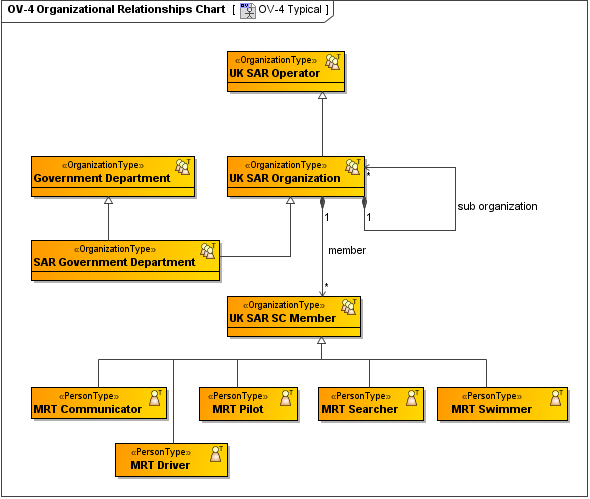Description
The OV-4 shows organizational structures and interactions. The organizations shown may be civil or military. The OV-4 exists in two forms; role-based (e.g., a typical brigade command structure) and actual (e.g., an organization chart for a department or agency).
A role-based OV-4 shows the possible relationships between organizational resources. The key relationship is composition, i.e., one organizational resource being part of a parent organization. In addition to this, the architect may show the roles each organizational resource has, and the interactions between those roles, i.e., the roles represent the functional aspects of organizational resources. There are no prescribed resource interactions in DoDAF V2.0: the architect should select an appropriate interaction type from the DM2 or add a new one. Interactions illustrate the fundamental roles and management responsibilities, such as supervisory reporting, Command and Control (C2) relationships, collaboration and so on.
An actual OV-4 shows the structure of a real organization at a particular point in time, and is used to provide context to other parts of the architecture such as AV-1 and the CVs.
The intended usage of the role-based OV-4 includes:
- Organizational analysis.
- Definition of human roles.
- Operational analysis.
The intended usage of the actual OV-4 includes:
- Identify architecture stakeholders.
- Identify process owners.
- Illustrate current or future organization structures.
Implementation
OV-4 can be represented using:
- An OV-4 diagram which is based on the UML Class diagram.
- A UML Class diagram.
- A SysML Block Definition diagram.
The organizations that are modeled using OV-4 may also appear in other models, for example in the SV-1 Systems Interface Description as organizational constituents of a capability or a resource and PV-1 Project Portfolio Relationships where organizations own projects. In a SV-1 Systems Interface Description, for instance, the organizational resources defined in a typical OV-4 may be part of a capability or resources. Also, actual organizations may form elements of a fielded capability which realizes the requirements at the system-level (again, this may be depicted on a SV-1 Systems Interface Description).
